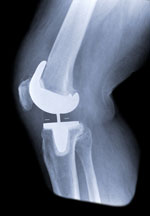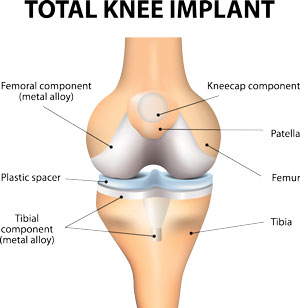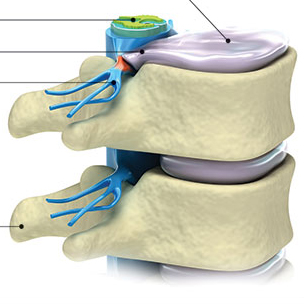Knee Replacement
 Quality of life is never to be underestimated, and when a knee problem is so debilitating that it is impossible to enjoy hobbies that are important to you, it is crucial to seek medical help.
Quality of life is never to be underestimated, and when a knee problem is so debilitating that it is impossible to enjoy hobbies that are important to you, it is crucial to seek medical help.
Fortunately, before even considering knee replacement surgery as an option, generally physicians will try to find other ways of assuaging the pain. For instance, physical therapy, analgesics and walking aids might be the answer to many knee problems, including those stemming from arthritis.
However, it is also nice to know that when other treatments prove to be futile, knee replacement surgery is an option. So prevalent is this surgery, in fact, that approximately 323,448 total knee replacements were performed in 2001. Knee replacement can help renew the ability to participate in many normal, daily activities such as gardening, going on walks, golfing and overall mobility. It is important to try other options before knee replacement surgery, however, since they only last for 15 to 20 years and are not easily replaced. For this reason, physicians are very selective about the types of candidates for the surgery.
Who is a candidate?
Total knee replacement is reserved for the patient who has not benefited from conservative treatments and whose quality of life is suffering due to the debilitation caused by knee pain. Examples include those experiencing pain at night and those who cannot perform their normal, everyday activities.
Knee replacement is also generally reserved for those who are over 60 years of age who are in relatively good health. Generally, this means that they maintain a healthy weight, do not suffer from cardiovascular problems, and are not suffering from a terminal illness.
Who is not a candidate?
As mentioned before, to receive knee replacement surgery, you must be a good candidate. If not, surgery could prove counterproductive. For some, knee replacement surgery is not in their best interest. Those who are too young (except for those who suffer from severe rheumatoid arthritis) should consider other types of treatment for knee pain, since after 15 or 20 years, the prosthesis will need to be replaced. Unfortunately, the bone will need to be cut short to make room for a new prosthesis, and function and mobility is likely to be damaged during the second operation. Those who are overweight are not good candidates, as the prosthesis (just as the natural knee) is designed to carry a weight in proportion to the person’s body. Too much weight on the prosthesis can cause it to be damaged, and subsequent knee surgeries will be necessary. Those with cardiovascular problems and terminal illnesses are also not good candidates, as the surgery may be too much for the body to handle. Also, those with poor skin coverage over the knee are not good candidates, as surgery could impair movement of the knee.
What knee replacement surgery is like?
During knee replacement surgery, you will be under general anesthesia meaning you will be asleep and without pain during the entire procedure, which usually lasts a few hours. The knee is opened up and the kneecap is moved out of the way. Doctors then, shave off the bottom of the femur and the top of the tibia and fibula bones. The prosthesis is then glued to the bones with special, surgical cement. The knee is then sutured back together and drainage tubes are used to prevent clogging.
Usually, a hospital stay for knee replacement surgery lasts between four and five days. During your time at the hospital, your leg will be attached to a device called Continual Passive Movement (CPM), which will move your knee to prevent stiffness. After the hospital stay, the patient will probably require the aid of a walker for a few days before putting full weight on the leg. Overall, full recovery can take anywhere from two months to one year although dramatic improvements should be seen sooner than that.
 Our approach to total knee replacement
Our approach to total knee replacement
- Incisions will be as long as needed to place components correctly
- Navigation is a helpful tool for greater surgical precision and a reasonable decrease in incision length
Advantages of ceramic-on-ceramic technology
Ceramic-on-ceramic technology presents the possibility of longer-lasting joints.
- Concerns over osteolysis caused by the use of polyethylene
- Need more durable bearing solution for the high demand patient
- Long clinical history
The procedure
During knee replacement surgery, you will be under general anesthesia. The knee is opened up, and the arthritic cartilage is removed. The prosthesis is then "glued" to the bones with special, surgical cement. The knee is sutured back together, and drainage tubes are used to prevent clogging.
Usually, a hospital stay for knee replacement surgery lasts between four and five days. During your time at the hospital, your leg will be attached to a device called continual passive movement (CPM), which will move your knee to prevent stiffness. Overall, full recovery can take anywhere from two months to one year, although dramatic improvements should be seen sooner than that.
Types of knee replacement surgery
- Femoral - replaces arthritic portion of thigh bone
- Tibial - replaces arthritic portion of shin bone
- Tibial insert - replaces cartilage and acts as shock absorber
- Patella - replaces knee cap

Uni-Compartmental Knee Replacement
Uni-compartmental knee replacement is a minimally invasive surgery that removes and resurfaces damaged articular cartilage in a single area of the knee. The goal of this procedure is a quick return to activity and pain relief. Benefits include maintaining two-thirds of the natural knee and relieving pain through minimally invasive techniques.
During the procedure, the patient is under general anesthesia, and an incision is made. The surgeon then removes the arthritic surface at the end of the thigh bone or femur and prepares the bone for a new covering. Then the femoral component is attached, and the arthritic surface on top of the shin bone is removed. A metal tray (tibial tray) is placed on top of the remaining bone, and the tibial insert is locked into the tray. Finally, the incision is closed.
The future of joint replacement surgery
Scientists are currently in the process of developing joint replacement methods that will last much longer than the current prototype. While doctors now use a glue to bind the old bone with the new prosthesis, they one day hope to use ceramics as a bone substitute.
When a bone breaks in the body, the bone cells will form together to rejoin the broken bone. In the same way, bone cells can join with coral or ceramics forming one, continuous bone. While the glue or cement that doctors use will eventually deteriorate, ceramics will last much longer as they have better chances of being accepted by the cells. While recovery may take longer initially, the effects of surgery will last much longer than current replacement methods.








